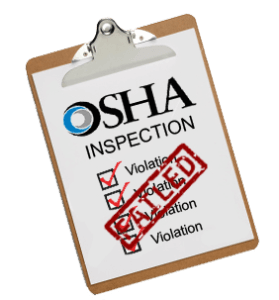This blog post is Part 2 of our “How To Manage an OSHA Inspection” series and discusses what to expect in the aftermath of the inspection.
Part 1 discussed how to properly manage an OSHA inspection from when the inspector arrives at the front door, through to completion of the closing conference, and everything in between. If you missed it, check it out HERE.
Part 2 will discuss what to expect after the inspection, how to correct identified violations and how to plan and prepare for protesting and appealing any potential citations through OSHA’s “Informal Conference” process.
The information is most applicable to manufacturing and other general industry businesses, but is also applicable to the construction industry.
It’s also helpful to gain a better understanding of what it actually means to manage OSHA compliance as part of your response to the inspection. Doing so will give you a “big picture” understanding of what needs to be done.
Just Because The Inspector Has Left The Building, Doesn’t Mean It’s Over

Before getting into the details, it’s important to point out that many companies make the mistake of believing that “the inspection is over and done with” once the inspector leaves. I’ve heard on several occasions comments like, “ya, they inspected us a while back and we’ve heard nothing since, so we must be fine.” Unless the inspector specifically stated during the Closing Conference that no citations will be issued, and unless they put that in writing, this assumption couldn’t be further from the truth. It’s important to understand that OSHA has up to 6 months to issue citations once the initial inspection is completed. In most cases, citations will be mailed and issued within 1-2 months of the inspection, but we’ve seen citations arrive during the 5th month too, right up against the 6 month deadline. You never know, but typically short and simple inspection will result in quicker citation turnaround times, while more complex “comprehensive” OSHA inspections (the kind that include not only physical hazard inspections, but also employee training records, written program reviews, health exposure test result reviews, etc..) often take up to 6 months before citations are issued. This is because all citations that are noted and recommended by the inspector must undergo a thorough review by more senior OSHA officials and lawyers before final citations can be issued. This can end up being a time consuming process for complex inspections.
What To Do Once The Inspector Leaves
Let’s walk through the steps of what your company should do once the initial OSHA inspection is completed:
- The first step is to meet with all staff involved with the inspection, discuss what occurred, and then draft a narrative report describing exactly what occurred during the inspection. Make sure to include relevant photos, notes, etc with the report. This process should begin immediately following the inspection while everything is still “fresh” in everyone’s minds. Waiting until months later will yield much poorer results. This information can end up being critical to any appeal process.
- If during the review process it’s determined or suspected that any violations are unfair or incorrect, then immediately gather relevant supporting evidence and attach with the report. This could include training or testing records, etc.. This can also include cases where employees are noted for not wearing PPE (Personal Protective Equipment), but where either the company has made/provided necessary PPE available and especially when employees have been formally trained on how to use PPE (and that training was documented). When companies can document that this is the case, they can often claim “employee misconduct” to appeal such citations. The case can be solidified if the company has evidence of internal enforcement efforts, such as written warnings, emails, etc., especially when signed by the offending employee(s).
- If you plan on protesting and appealing potential citations, use this report to create a “ defense presentation” to be later used during the informal conference. We’ve gone so far as to create a Power Point presentation with photos, etc.. The more organized, educated and committed you are, the better! Again, it’s best to start this process early rather than wait months by which time motivation and memory will have faded!
- The next pressing issue should be immediate abatement and correction of any violations noted by the compliance officer. Depending on the types of violations, this could include correction of physical hazards on the shop floor, to remedial employee health and safety training, conducting health exposure testing, or even drafting your health and safety manual. If your company isn’t sure how to make appropriate corrections, then consult with a qualified person or 3rd party consultant as necessary. This is critical because nothing is worse than failing to make proper corrections and having OSHA return to find the same violations in existence!
- Once abatements are completed, be sure to record each with photos, documents, etc. and confirm and consult with proper supervision, your lawyer, or a 3rd party health and safety consultant to ensure that everything was done correctly. If you’re still unsure, you can always call the enforcement officer to seek their advice but this can be risky depending on the situation. Then draft a letter to the OSHA enforcement officer to make them aware of the corrections. This is vital so that the inspector, and his or her superiors, know that steps have been taken to correct any health and safety hazards and issues identified during the inspection.
- Another critical step is to instruct relevant management and administrative staff to be on the lookout for the citation letter. This is critical, because you’ll only have 2 weeks upon receipt of the letter, to contact the local OSHA office to request and schedule an informal conference to appeal any potential citations. In other words, the “clock starts ticking” as soon as the letter arrives. Surprisingly enough, many companies fail to do this and end up missing the deadline, and thus end up having to accept all citations and full fines and penalties. This can be a disaster depending on the scope of citations. We’ve had more than one client do this, so be aware and don’t let it happen to you!
- Once the citation letter arrives, gather a meeting of all relevant staff members to review and discuss. Make sure to review the initial report that was created after the inspection (you did that, right???) and search for any potential discrepancies in the citations and make note of each.
- You must also immediately post the citation letter where all employees can view it (in lunch room for example), and post all abatement certifications wherever citations occurred during the original inspection.
Should You Contest OSHA Citations and Fines?
If you’re confident in your ability to defend your position and appeal any or all citations, then immediately contact OSHA to schedule an informal conference.
An “informal conference” is an opportunity to meet with the local OSHA director and enforcement officer to formally contest and discuss the citations. If you decide on this option, it’s critical that you’re fully prepared to defend your company by offering concrete evidence that the citations are invalid. This normally means having formal records including copies of your written programs, training records, etc. Without this sort of evidence, your chances of success are not good. However if you do have solid evidence, then your chances of getting citations and fines dismissed or reduced are good.
Once the informal conference is scheduled, make sure to reconvene a meeting with relevant staff to review the defense presentation and make any final edits and tweaks one final time.
Another important note: Make sure that at least one SENIOR management team member, up to and including a CEO or owner, attend the conference. OSHA is always looking for evidence of “management commitment,” and nothing screams management commitment more than involvement from senior company leadership. The importance of this cannot be overstated. We’re not suggesting that it’s mandatory, or that the informal conference will be a waste of time without them, but believe me when I tell you that the OSHA office will appreciate and make note of their involvement, which could significantly impact the final resolution agreement. We were involved in 2 different client situations where the business owners attended informal conferences and participated in the discussions. In one case, the main Serious citation and fines were totally removed from their record, and in the other, several citations were removed or reduced as well as fine amounts. There were certainly other considerations involved in these situations, but there’s no doubt that this impacted these outcomes.
We have actually had much success helping our existing clients through this process and getting citations dismissed. It’s always possible, but only for companies who have an existing and functioning OSHA compliance program, including a comprehensive safety training plan and especially if they can demonstrate management commitment.
Expedited Settlement Offers:
On another note, and assuming that OSHA issues citations, they may offer what’s called an “Expedited Settlement” where they’ll likely offer to reduce the stated fine by 40% in exchange for what amounts to an admission of guilt for the citation, and immediate payment of the fine.
While this might sound good from a money and time perspective, the problem is that the citation(s) will remain on your record, which means that for up to 5 years OSHA can issue your company a “Repeat” citation if they conduct a follow up inspection (which they almost always do sooner or later) and note the same/similar violation. The maximum for Repeat citations is now just under $136,000 each. Also, when OSHA finds Repeats, they often get much more aggressive and will doggedly search for additional citations.
OSHA routinely offers these expedited agreements if they feel that the offending company is committed and capable of making recommended corrections.
If they offer this, we recommend that you don’t accept it and instead request the Informal Conference to fight the citations. There’s no guarantee of success, but it’s worth the effort in our opinion.
Closing Thoughts:
We hope that you’ve found this 2 part series on how to manage OSHA inspections helpful and that you’ll use the provided advice to your advantage in the event that you’ve been inspected and cited by OSHA, or are preparing a plan to deal with this possibility. Never forget that the best way to prevent and manage OSHA inspections is to build a safety compliance program.
Worried About OSHA Compliance & Potential Liabilities?
We’ve Helped Many Texas Companies Get OSHA Compliant and Can Help Yours Too!
Click Here or Call 512-457-0374 To Learn More About How We Can Help
